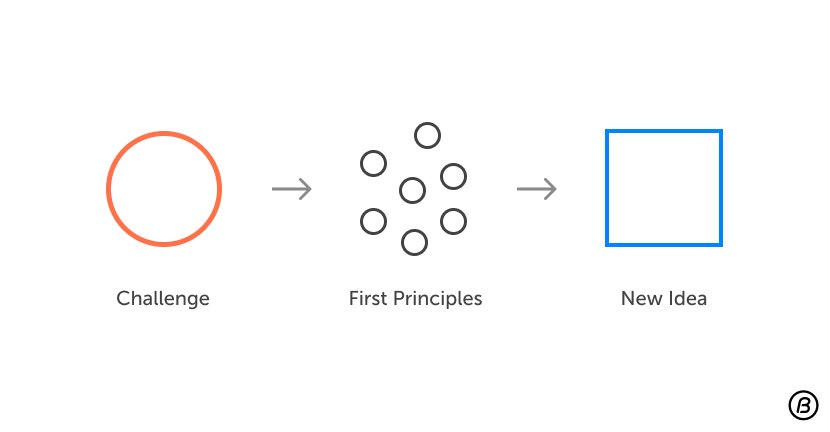
Btrax Design Company > Freshtrax > Elon Musk’s “Fi...
Elon Musk’s “First Principles Thinking” and How It Can Be Applied to UX Design
When it comes to approaches for generating new ideas, innovations, and efficient yet innovative solutions in startups or new business departments, what comes to mind?
Have you ever heard of the term “First Principles Thinking”?
Elon Musk, the founder of SpaceX and Tesla, is famous for using this innovative approach, often drawing comparisons to the Marvel character Tony Stark.
In this article, we’ll explore what First Principles Thinking is using real-life examples and ways that you can apply it in your work, especially in UX design.
What is First Principles Thinking?
First Principles Thinking is a problem-solving approach that involves breaking down complex problems into their most basic, fundamental elements.
By identifying the core principles or truths, you can then build new solutions from the ground up, free from preconceived notions or existing frameworks. This method allows for fresh perspectives and innovative solutions.
One of the modern advocates for this thinking is Elon Musk, although the concept dates back over 2,000 years to the philosopher Aristotle. Musk has popularized this approach in recent times, using it to drive significant advancements in technology and business.

A Case Study: SpaceX’s Rocket Launch Innovation
A prime example of First Principles Thinking is SpaceX’s dramatic reduction in rocket launch costs. Instead of asking, “How can we make rockets cheaper?” Musk began by considering, “What are rockets made of?”
By breaking down the materials and processes involved in building rockets, Musk discovered that manufacturing the components for his rockets in-house from raw materials like aluminum, titanium, and carbon fiber could substantially cut costs.

(Image:Unsplash SpaceX)
Moreover, Musk questioned the traditional practice of single-use rockets. By asking, “Why can’t rockets be reused?” he spearheaded the development of reusable rockets, culminating in the Falcon 9, which can return to Earth and be launched again, further reducing costs.
Three Steps to Implementing First Principles Thinking
Here are three practical steps that may help you apply First Principles Thinking to problem-solving:
1. Identify and Define Current Assumptions
The first step is to identify and define your current assumptions about the problem at hand. This requires you to take a step back and critically evaluate the existing beliefs and practices that are shaping your understanding of the issue.
For example, in the context of UX design, this might involve questioning why certain user interface elements are arranged the way they are or why specific user flows are designed in a particular manner. By bringing these assumptions to light, you set the stage for deeper analysis and creative problem-solving.
2. Break Down the Problem into Fundamental Principles
Next, deconstruct the problem into its most basic elements. This step is about stripping away the complexities and focusing on the foundational aspects of the problem.
For instance, if users find it difficult to navigate a website, you would break down the navigation issue into its core components: the structure of the site, the clarity of visual cues, and the responsiveness of the interface. By understanding these fundamental principles, you gain a clearer view of the true nature of the problem, free from the clutter of secondary issues and traditional solutions.
3. Create New Solutions from Scratch
Finally, use these basic elements to build new solutions from scratch. This step involves leveraging the insights gained from the fundamental analysis to innovate without being constrained by existing frameworks or conventional wisdom.
In UX design, this might mean designing a user interface that bypasses common design patterns in favor of a layout that directly addresses the user’s primary needs and behaviors. By focusing on the core principles, you can create solutions that are not only innovative but also highly effective and user-centric.
(Reference:”Elon Musks’ “3-Step” First Principles Thinking: How to Think and Solve Difficult Problems Like a Genius”)

(画像:Getty Images from CNBC) by Mayo Oshin)
Applying First Principles Thinking in UX Design
Design is fundamentally about solving problems. By leveraging First Principles Thinking, you can enhance user experience (UX) design significantly. Here’s how you can apply the three steps in UX design:
Identify and Define Current Assumptions
The first step is to reevaluate the assumptions in your current UX design. For instance, consider common UI elements and user flows. Conduct usability tests to understand specific problems users face. For example, if your design isn’t intuitive, identify why. Perhaps the user journey is too complex or the information layout is confusing.
Break Down the Problem into Fundamental Principles
Next, decompose the problem to understand the root cause of design issues. If users struggle to find a particular feature, analyze what is impeding discoverability. Look into navigation structure, visual cues, and user feedback mechanisms.
Create New Solutions from Scratch
Finally, develop new design solutions based on fundamental principles. Simplify complex tasks into single steps where possible. This might involve using AI for personalized experiences or automated processes to reduce user effort.

Real-World UX Design Applications
Redesigning Navigation
Assumption: Users understand the existing navigation menu.
Breakdown: Analyze user behavior data to identify frequently used features.
New Solution: Add shortcuts to frequently used features and simplify menu structures like dropdowns or hamburger menus.

Improving Form Design
Assumption: Users are comfortable with long forms.
Breakdown: Identify points where users drop off and analyze form fields.
New Solution: Break forms into steps and minimize required information, using autocomplete and progressive disclosure to ease the user’s burden.

Collecting User Feedback
Assumption: Users willingly provide feedback.
Breakdown: Understand the barriers users face in giving feedback.
New Solution: Implement interactive feedback widgets to make sharing opinions easier and use pop-ups or tooltips to encourage feedback.

Conclusion
First Principles Thinking is a powerful tool for generating new solutions and innovations by returning to the basics and thinking without being constrained by existing frameworks.
In UX design, understanding the fundamental needs and behaviors of users and building new design solutions from there can result in more intuitive and user-friendly products. Of course, this way of thinking is not a panacea, but it can serve as a valuable hint for innovation and problem-solving in new business ventures and startups…
Interested in how btrax can help your company or brand with innovation?
Contact us to see how we can help, whether you’re looking to enter or grow your brand in the Japanese or US markets.







